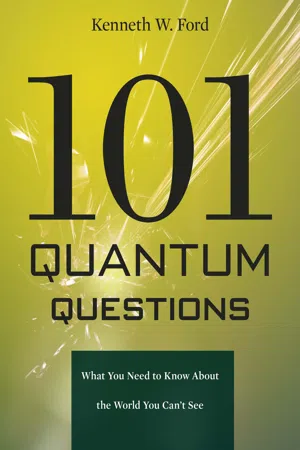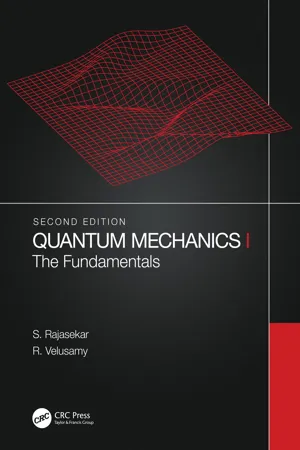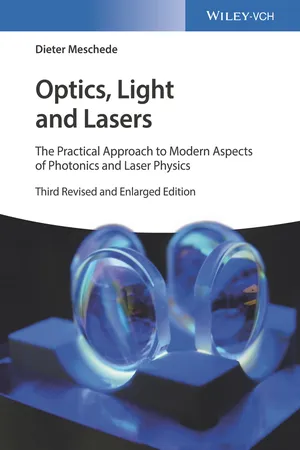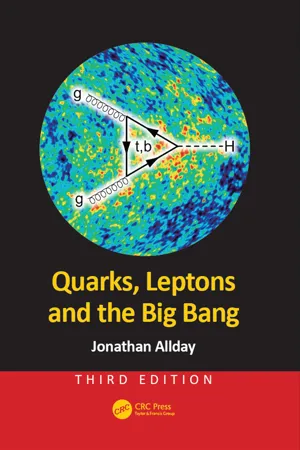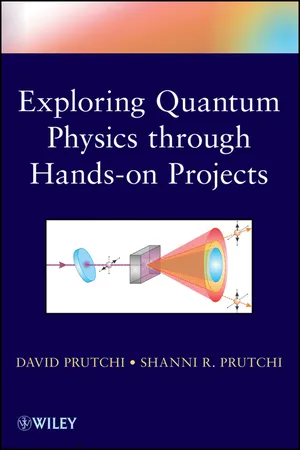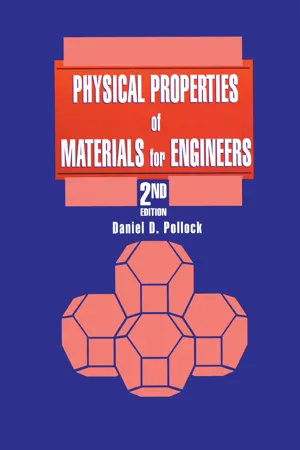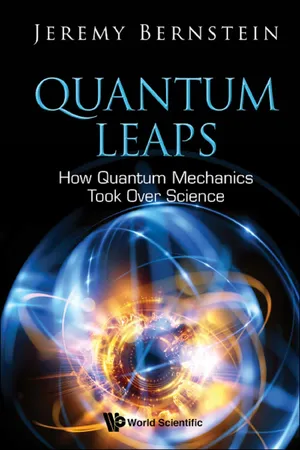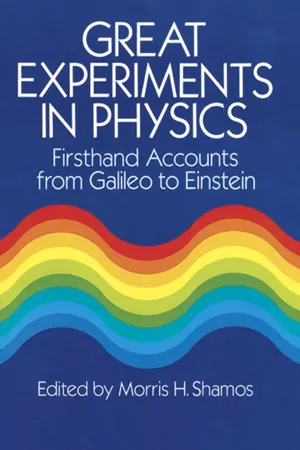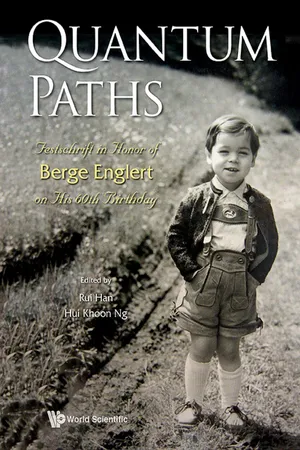Physics
Double Slit Experiment
The double slit experiment is a fundamental physics experiment that demonstrates the wave-particle duality of light and matter. It involves shining a light source through two closely spaced slits onto a screen, resulting in an interference pattern characteristic of waves. This experiment has been crucial in shaping our understanding of quantum mechanics and the behavior of particles at the quantum level.
Written by Perlego with AI-assistance
Related key terms
Related key terms
1 of 4
Related key terms
1 of 3
11 Key excerpts on "Double Slit Experiment"
- eBook - ePub
- Kenneth W. Ford, Paul Hewitt(Authors)
- 2011(Publication Date)
- Harvard University Press(Publisher)
This experiment has been carried out with a light source so weak that no more than one photon is anywhere between the source and the detecting screen at any one time. It has also been carried out with electrons, and even with atoms. The result is always the same. A resulting pattern of light and dark bands shows that diffraction and interference have occurred and that the individual particles exhibit a wavelength.Some physicists say the two-slit experiment is the quintessential quantum experiment because it is so simple in concept and at the same time it so starkly illustrates the wave-particle duality. Consider, for example, the one-photon-at-a-time version of the experiment. One photon passes through the apparatus and lands somewhere on the detecting screen. But where? How does it “decide” where to land? It is guided only by probability. There are some places where it has a good chance to land, other places where it is less likely to land, and some places where it has no chance to land. Figure 49 shows a simulation in which the landing points of one, ten, one hundred, one thousand, and then ten thousand photons are shown (with each panel including the results of the panel above).* For up to ten photons no pattern at all can be discerned. The points look random. For one hundred photons one begins to see a pattern of darker and lighter bands. At one thousand photons the pattern becomes more evident, and at ten thousand photons the pattern conforms to the classical expectation of light and dark bands of constructive and destructive interference.How is one to interpret the results of the one-photon-at-a-time experiment? How does each photon know where to land—and where not to land? Does it know where other photons have already landed? If a photon passes through one slit, how does it know that the other slit is there (for if only one slit were open, the pattern would be quite different)? Einstein called quantum physics spooky. Richard Feynman described the twoslit experiment as the essence of quantum physics. There appears to be only one way to interpret the experiment: Each photon separately acts as a wave—a wave that passes through both slits—guided solely by the probability associated with that wave, entirely independent of what other photons that went before it may have done. - eBook - ePub
Quantum Mechanics I
The Fundamentals
- S. Rajasekar, R. Velusamy(Authors)
- 2022(Publication Date)
- CRC Press(Publisher)
Essentially, the arrangement of the Double Slit Experiment appears to induce particle or wave charcter of light. To make things very clear we can consider a Mach–Zehnder interferometer experiment an equivalent experiment of the Double Slit Experiment. To test whether light priorily get the information about the experimental set up in the Double Slit Experiment John Archibald Wheeler proposed a gedanken delayed-choice experiment with the Mach–Zehnder interferometer. This thought experiment was then realized experimentally using various systems. An experiment was proposed to observe simultaneously both particle and wave character of the quantum through quantum entanglement. We discuss these developments in the present chapter.21.2 Single Slit and Double Slit Experiments
We consider the slit experiments with a beam of particles and with one particle at a time [1 ].21.2.1 Experiments With Particle
The experimental set up for the Double Slit Experiment with particle is shown schematically in Fig. 21.1 . Let a, d and L are width of a single slit, the distance separation of the two slits and the distance separation of the slits and the screen, respectively. A parallel beam of microscopic particles with constant velocity v is made to fall on a double slit.FIGURE 21.1Schematic of double slit apparatus.Suppose we first close the lower slit allowing the particles to pass only through the upper slit. Then we will get the single slit diffraction pattern at the screen. Classical diffraction theory gives the intensity of the single slit diffraction pattern as [1 , 2 ]I ( ϕ ) =(21.1)I max, ϕ =2sin ααtan− 1z L, α =,π a sin ϕλwhere ϕ is as defined in Fig. 21.1 . The intensity of the single slit diffraction pattern is shown in Fig. 21.2 . If the upper slit is closed allowing the particles to pass only through the lower slit we will again get the same diffraction pattern displaced downwards by the slit separation d. Classical theory explains successfully the diffraction pattern of a single slit.FIGURE 21.2Intensity of single slit diffraction pattern (Eq. (21.1)) for,I max= 1L = 1 m,a = 600 nmandλ = 632.8 nm - eBook - ePub
Optics, Light and Lasers
The Practical Approach to Modern Aspects of Photonics and Laser Physics
- Dieter Meschede(Author)
- 2017(Publication Date)
- Wiley-VCH(Publisher)
We have dealt with double-slit interference as a pure wave phenomenon in the previous section, and we have also already referred to the application to other wave phenomena, in particular to matter waves. In this context, there is a very well-known phenomenon that bothers our intuition quite hard: an interference pattern is also generated by a single particle, by so-called self-interference. Although we always detect only one particle, its matter wave must have gone through both slits simultaneously! We infer this interpretation from the way in which quantum mechanics deals with it theoretically. It has been proven by experiments time and again, but stands in bizarre contradiction to our natural, that is, macroscopic, view of a “particle.”The first demonstration of the double-slit experiment with matter waves was given by Möllenstedt and Düker [72] using electron beams. For that experiment an electron beam was collimated and sent through an electric field arrangement corresponding to a Fresnel biprism. Later optics with atomic matter waves [75] has been established as yet variant. With helium atoms a double-slit experiment has been carried out in perfect analogy to Young's experiment [73]. On the one hand, the de Broglie wavelength of neutral atoms with mass and velocity within the atomic beam is very small, pm. That is why very tiny slit widths and separations had to be used, m, in order to obtain resolvable diffraction. The atomic flux was accordingly very small. On the other hand, helium atoms in the metastable S state can be detected nearly atom by atom by means of channel plates. This high detection sensitivity has made possible the atomic Young's experiment with neutral atoms.In the lower part of Figure 6.4 - eBook - ePub
- Jonathan Allday(Author)
- 2016(Publication Date)
- CRC Press(Publisher)
Gradually, thanks to the work of Niels Bohr, Werner Heisenberg, Max Born, Erwin Schrödinger and Paul Dirac (amongst others), a new picture started to emerge. The process was one of continual debate amongst groups of scientists, trying out ideas and arguing about them until a coherent way of dealing with the atomic world was produced. Along the way, many cherished ideas had to be abandoned as well as deep-set assumptions about the nature of reality.The history of the development of quantum mechanics is a fascinating human story in its own right. However, we must content ourselves with developing enough of the ideas to help us understand the nature of the fundamental forces.1 Two experiments will provide the starting point for our exploration.3.1 THE DOUBLE-SLIT EXPERIMENT FOR ELECTRONS
A classic experiment that profoundly demonstrates the need for a new way of thinking about the atomic world is the double-slit experiment for electrons. It is a simple experiment to describe (although somewhat harder to do in practice) considering how fundamentally it has shaken our instinctive concepts about the nature of reality.In essence, the experiment consists of a beam of electrons directed at a metal screen, into which have been cut two rectangular slits. The slits are placed quite close to each other, so that the width of the beam spans both slits, and they are very narrow.The electron beam can be produced in a simple way using an ‘electron gun’.2 It’s important though to have the ability to reduce the intensity of the beam, allowing careful control of the number of electrons striking the screen per second.On the other side of the screen and some distance away is a mechanism for detecting the arrival of electrons. This can be a sophisticated electronic device such as used in particle physics experiments, or it can be a simple photographic film (of very high sensitivity). For simplicity, we are going to assume that a photographic film is being used. - eBook - ePub
- Zbigniew Ficek(Author)
- 2017(Publication Date)
- Jenny Stanford Publishing(Publisher)
quantum computer, where all possible calculations could be carried out simultaneously.6.8 Quantum InterferenceA beautiful illustration of the superposition principle is the interference phenomenon. Although interference is a classical wave phenomenon, it is also at the heart of quantum mechanics. It is usually illustrated with Young’s double-slit experiment, in which a beam of light is divided at two narrow slits into two beams that, after traveling separately for some distance, are recombined at an observation point.If there is a small path difference between the beams, interference fringes are observed at the observation (recombination) point. A schematic diagram of Young’s double-slit experiment is shown in Fig. 6.5 .Figure 6.5 Schematic diagram of Young’s double-slit experiment. Two light beams emerging from the slits S1 and S2 are brought together at the observing screen and the resulting light intensity is measured at various positions.The observed intensity is a pattern of alternating bright and dark strips, called interference fringes. Understanding the reason for this interference is not difficult. It may be explained using classical description of the process. The paths from each slit to a given point on the observation screen are not necessarily equal, so the beams traveling from the slits arrive with different phases of propagation. Due to the phase difference, the two beams will yield constructive interference (bright strips) if they are in phase at the observation point and destructive interference (dark strips) if they are 180° out of phase with each other.aThe interpretation of the interference phenomenon becomes more subtle when the light beams are replaced by individual photons or particles. What happens is that when single photons or particles are used and the experiment is repeated many times, it is observed that the resulting pattern on the screen is identical to that observed with the light beams. This seems to imply that the individual photons had passed through both slits at the same time and interfered with themselves. Dirac first noticed this strange behavior, and his statement is now cited as the famous phrase “each photon interferes only with itself. Interference between different photons never occurs.” - eBook - ePub
- Michael M. Mansfield, Colm O'Sullivan(Authors)
- 2020(Publication Date)
- Wiley(Publisher)
monochromatic light) from a primary source are directed onto two narrow parallel slits. Even if the primary source is not equidistant from the slits, they still act as coherent sources since there is a constant phase difference between them.A double‐slit arrangement: the slits act as two sources oscillating in phase.Figure 22.16We now analyse the diffraction pattern produced in the case of a plane wave which is incident normally on two parallel slits (narrow openings in an opaque screen), each of width a, which are separated by a distance b, as illustrated in Figure 22.17 .Again, we divide each slit into identical infinitesimal strips and add the contribution from each strip using a vector diagram. Consider first the slit AB. Figure 22.18 represents the addition of amplitudes from the infinitesimal strips which make up AB and is essentially the same as the single slit diagram (Figure 22.12 ) and thus, as before, , where2αis the phase difference between the first and the last strip in the slit.Two slit diffraction: the diffraction of a plane wave which is incident perpendicularly on two narrow parallel slits.Figure 22.17We now add the contribution from each of the two slits AB and CD, each of amplitudeA1, to produce the diagram shown in Figure 22.19 . Note that there is an opaque section BC between the two single slit diagrams. As indicated in Figure 22.17 the path difference between waves from point A on slit AB and point C on slit CD is(a + b) sin θ - David Prutchi(Author)
- 2012(Publication Date)
- Wiley(Publisher)
Figure 89b . This result could be interpreted as meaning that light really is conveyed as a wave, since interference occurs, but at the same time, a single hit is detected on the screen at any given time, indicating that single photons are flying through the apparatus. Hence, the emergence of an interference pattern suggests that each photon interferes with itself, and therefore each photon must be going through both slits at once!In 1909, about a century after Young carried out his original double-slit experiment, British physicist G. I. Taylor performed a similar experiment in a very dark room, using a photographic plate as the screen on which he showed that even the feeblest light source—equivalent to “a candle burning at a distance slightly exceeding a mile”—could lead to interference fringes.TWO-SLIT INTERFERENCE WITH SINGLE PHOTONS
Taylor exposed photographic plates for up to 3 months to obtain interference patterns using his very weak light source. Today, we can conduct the same experiment within a few minutes, using the setup shown in the block diagram of Figure 90 . The basic idea remains the same—to illuminate the double slit with a very weak beam. So weak in fact, that there is a reasonably high assurance that only a single photon of the laser beam is present in the device at a time.Figure 90 This is the experimental setup that we constructed to demonstrate single-photon interference. Just as in the experiment of Figure 33 , a laser beam is attenuated with neutral-density filters of at least D = 6.73, to the point where only one photon is present within the apparatus. Each photon then passes through a double slit. We used an extremely sensitive TV camera to detect the individual photons. Two HeNe-line band-pass filters (Edmund Industrial Optics model NT43-133) and two apertures (1-in. flat washers from the hardware store) keep stray, nonlaser photons from adding to the noise.As shown in Figure 90 , the distance between our two-slit slide and the detector is 10 cm, which means that a photon takes:to traverse this distance. As such, at most one photon hits the photocathode as long as photons arrive at a frequency of less than 1/0.33 [ns] = 3.03 × 109- eBook - ePub
- Daniel D. Pollock(Author)
- 2020(Publication Date)
- CRC Press(Publisher)
FIGURE 2-7. Schematic sketch of the G. I. Taylor experiment.If a photon is a particle, it would only be able to pass through one slit at a time. The resultant diffraction pattern then would be quite different from that obtained. The observed pattern can be caused only by the simultaneous passage of a photon through both slits. How could the photon, a single particle, have passed through both slits at the same time? It would thus appear that the behavior of a photon can be significantly different from that presented earlier for either particles or waves. Actually, it is not possible to know the exact nature of a photon when an attempt is made to examine it too closely. It may be concluded that this is true for any quantum particle, including the electron.2.7 HEISENBERG UNCERTAINTY PRINCIPLE
Photons and electrons may be described in terms of waves, but this approach has inherent limitations. The greater the attempt that is made to study the nature or behavior of a photon or a particle, the greater will be the uncertainty or error of the measurements. Heisenberg summarized this in his uncertainty, or indeterminacy, principle. This concept was demonstrated by means of idealized “thought” experiments.If it is desired to “see” an electron in such an experiment, a photon “reflected” from the electron must enter a microscope so that the electron may be observed. Both the photon and the electron will interact in the same way as described to explain the Compton effect (Section 2.5 ). The photon will undergo a change in momentum and will be diffracted if and when it enters the microscope. Knowledge of the position of the electron will depend on the diffraction pattern of the photon (Figure 2-8 ) and the degree of sharpness with which the microscope can resolve an object.It is most probable that the photon will fall within the central maximum of the diffraction pattern because the greatest number of photons are found there. However, the sharpness of the image of the electron, which is projected upon the screen, will be affected by the small maxima that appear concentrically about the central maximum; the resulting outline of the image of the electron will be fuzzy. This occurs because much smaller, but equally valid, probabilities exist that a photon will fall in any of the smaller intensity maxima that appear around the central maximum. - eBook - ePub
Quantum Leaps
How Quantum Mechanics Took Over Science
- Jeremy Bernstein(Author)
- 2019(Publication Date)
- WSPC(Publisher)
Chapter 4
A Double Slit
“We chose to examine a phenomenon which is impossible, absolutely impossible, to explain in any classical way, and which has in it the heart of quantum mechanics. In reality it contains the only mystery.”Richard Feynman1“ . . . The particle world is the dream world of the intelligence officer. An electron can be here or there at the same moment. You can choose. It can go from here to there without going in between; it can pass through two doors at the same time, or from one door to another by a path which is there for all to see, until someone looks, and then the act of looking has made it take a different path. Its movements cannot be anticipated because it has no reasons. It defeats surveillance because when you know what it is doing you can’t be certain where it is, and when you know where it is you can’t be certain what it’s doing: Heisenberg’s uncertainty principle; and this is not because you’re not looking carefully enough, it is because there is no such thing as an electron with a definite position and definite momentum; you fix one, you lose the other, and it’s all done without tricks, it’s the real world, it is awake.”Tom Stoppard, Hapgood2In the fall of 1947, I entered Harvard College as a seventeen-year-old freshman. I had no real ideas about my future, except that I was quite sure that it would have nothing to do with science. I had no interest in science. But at that time the President of the university was James Bryant Conant, a chemist who had played a very important role in the creation of nuclear weapons. This experience had left him with a good deal of concern about this new force in the world. One manifestation of this was the notion that every Harvard graduate should have some sort of scientific education. He knew, of course, that most of us would not have careers in science, but we might well have careers where we would have to make decisions that involved science. So under the rubric of “General Education” a set of natural science courses had been instituted which presented non-mathematical surveys of different scientific fields. Every Harvard graduate was required to pass one of them unless he—there were no ‘she’s—was a science major. You also had to be able to swim two laps of a twenty-five-yard long pool. Faced with the former obstacle, I consulted the Harvard Confidential Guide to Courses - eBook - ePub
Great Experiments in Physics
Firsthand Accounts from Galileo to Einstein
- Morris H. Shamos, Morris H. Shamos(Authors)
- 2012(Publication Date)
- Dover Publications(Publisher)
It has been shown that two equal series of waves, proceeding from centers near each other, may be seen to destroy each other’s effects at certain points, and at other points to redouble them; and the beating of two sounds has been explained from a similar interference. We are now to apply the same principles to the alternate union and extinction of colors (Fig. 1.). The light must be coherent. Probably Young learned this experimentally. Young’s double-slit experiment. In order that the effects of two portions of light may be thus combined, it is necessary that they be derived from the same origin, and that they arrive at the same point by different paths, in directions not much deviating from each other. This deviation may be produced in one or both of the portions by diffraction, by reflection, by refraction, or by any of these effects combined; but the simplest case appears to be, when a beam of homogeneous light falls on a screen in which there are two very small holes or slits, which may be considered as centers of divergence, from whence the light is diffracted in every direction. In this case, when the two newly formed beams are received on a surface placed so as to intercept them, their light is divided by dark stripes into portions nearly equal, but becoming wider as the surface is more remote from the apertures, so as to subtend very nearly equal angles from the apertures at all distances, and wider also in the same proportion as the apertures are closer to each other. The middle of the two portions is always light, and the bright stripes on each side are at such distances, that the light coming to them from one of the apertures, must have passed through a longer space than that which comes from the other, by an interval which is equal to the breadth of one, two, three, or more of the supposed undulations, while the intervening dark spaces correspond to a difference of half a supposed undulation, of one and a half, of two and a half, or more. FIG - eBook - ePub
Quantum Paths
Festschrift in Honor of Berge Englert on His 60th Birthday
- Hui Khoon Ng, Rui Han(Authors)
- 2015(Publication Date)
- WSPC(Publisher)
11 to investigate what constitutes a momentum transfer in a double-slit experiment. They call the usual momentum transfer, like that in Feynman’s light microscope, a “classical” kick; in addition, they define the concept of “quantum” momentum transfer. They find that the loss of interference need not be due to “classical” kicks. In this case the “quantum” momentum transfer cannot be less than that required by the uncertainty principle, so that these “quantum” kicks wash out the fringes.In this context, Eichmann et al .12 performed an experiment with a light interferometer, where the double slit is replaced by two trapped ions, which can store which-way information in internal states. This scheme was criticized9 , because the ions play a double role: they act as sources of elementary waves (just like a double slit) and simultaneously as a which-way detector. Hence the momentum transfer from the double slit and the which-way detector cannot be separated.Here we report on a which-way experiment with an atom interferometer. A microwave field is used to store the which-way information in internal atomic states. We study the mechanical effect of the which-way detection on the atomic centre-of-mass motion separately, and find that the “classical” momentum kicks are much too small to wash out the interference pattern. Instead, correlations between the which-way detector and the atomic motion destroy the interference fringes. We show that the back action onto the atomic momentum implied by Heisenberg's position-momentum uncertainty relation cannot explain the loss of interference.The atom Interferometer
Figure 1 shows a scheme of our atom interferometer. An incoming beam of atoms passes through two separated standing wave light beams. The detuning of the light frequency from the atomic resonance, Δ = ω light – ω atom , is large so that spontaneous emission can be neglected. The light fields each create a conservative potential U for the atoms, the so-called light shift, with U ∝ I /Δ, where I is the light intensity (see, for example, ref. 13 ). In a standing wave the light intensity is a function of position, I (z ) = I0 cos2 (klight z), where klight is the wavevector of the light. Hence the light shift potential takes the form U (z ) = U0 cos2 (klight z), with U0 ∝ I0
Index pages curate the most relevant extracts from our library of academic textbooks. They’ve been created using an in-house natural language model (NLM), each adding context and meaning to key research topics.
Explore more topic indexes
Explore more topic indexes
1 of 6
Explore more topic indexes
1 of 4
